Red crossbill
The red crossbill or common crossbill (Loxia curvirostra) is a small passerine bird in the finch family Fringillidae. Crossbills have distinctive mandibles, crossed at the tips, which enable them to extract seeds from conifer cones and other fruits.
| Red crossbill | |
|---|---|
.jpg.webp) | |
| Male red crossbill | |
.jpg.webp) | |
| Female red crossbill | |
| Scientific classification | |
| Kingdom: | Animalia |
| Phylum: | Chordata |
| Class: | Aves |
| Order: | Passeriformes |
| Family: | Fringillidae |
| Subfamily: | Carduelinae |
| Genus: | Loxia |
| Species: | L. curvirostra |
| Binomial name | |
| Loxia curvirostra | |
 | |
| Range of L. curvirostra Breeding Resident Non-breeding Vagrant (seasonality uncertain) | |
Adults are often brightly coloured, with red or orange males and green or yellow females, but there is wide variation in colour, beak size and shape, and call types, leading to different classifications of variants, some of which have been named as subspecies. The species is known as "red crossbill" in North America and "common crossbill" in Europe.
Description
Crossbills are characterized by the mandibles crossing at their tips, which gives the group its English name. Using their crossed mandibles for leverage, crossbills are able to efficiently separate the scales of conifer cones and extract the seeds on which they feed. Adult males tend to be red or orange in colour, and females green or yellow, but there is much variation.
In North America, nine distinct red crossbill variants (referred to as call types) differing in vocalizations as well as beak size and shape are recognized.[2] Each call type evolved to specialize on different species of conifer.[3]
Measurements:[4]
- Length: 20 cm
- Weight: 40-53 g
- Wingspan: 27–29 cm
Breeding and irruption
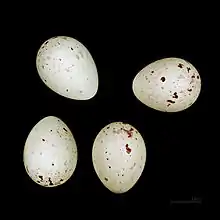
The red crossbill breeds in the spruce forests of North America, as well as Europe and Asia. Some populations breed in pine forests in certain areas of all three continents, and in North America, also in Douglas fir. It nests in conifers, laying 3–5 eggs.
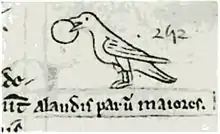
This crossbill is mainly resident, but often irrupts south when its food source fails. These irruptions led in the twentieth century to the establishment of permanent breeding colonies in England, and more recently in Ireland. This species forms flocks outside the breeding season, often mixed with other crossbills.
The first known irruption, recorded in England by the chronicler Matthew Paris, was in 1254; the next, also in England, appears to have been in 1593 (by which time the earlier irruption had apparently been entirely forgotten, since the crossbills were described as "unknown" in England).[5] The engraver Thomas Bewick wrote that "It sometimes is met with in great numbers in this country, but its visits are not regular",[6] adding that many hundreds arrived in 1821. Bewick then cites Matthew Paris as writing "In 1254, in the fruit season, certain wonderful birds, which had never before been seen in England, appeared, chiefly in the orchards. They were a little bigger than Larks, and eat the pippins of the apples [pomorum grana] but no other part of them... They had the parts of the beak crossed [cancellatas] by which they divided the apples as with a forceps or knife. The parts of the apples which they left were as if they had been infected with poison."[6] Bewick further records an account by Sir Roger Twysden for the Additions to the Additamenta of Matt. Paris "that in the apple season of 1593, an immense multitude of unknown birds came into England... swallowing nothing but the pippins, [granella ipsa sive acinos] and for the purpose of dividing the apple, their beaks were admirably adapted by nature, for they turn back, and strike one point upon the other, so as to show... the transverse sickles, one turned past the other."[6]
Taxonomy and systematics
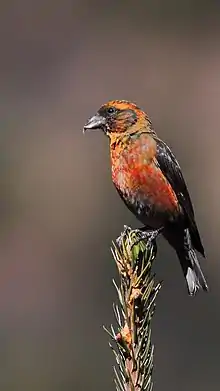
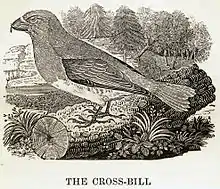
The genus name Loxia is from Ancient Greek loxos, "crosswise", and curvirostra is Latin for "curved bill".[7]
This species is difficult to separate from the parrot crossbill and Scottish crossbill, both of which breed within its Eurasian range, as plumage distinctions from those two species are negligible, though the head and bill are smaller than in either of the other species. Care is needed in identification, especially in Eurasia, where the glip or chup call is probably the best indicator. The identification problem is less severe in North America, where only the red crossbill and white-winged crossbill occur. However, there has been debate as to whether different call types should be considered separate species. For example, the Cassia crossbill, occurring in the South Hills and Albion Mountains in Idaho, has been described as a new species (Loxia sinesciuris) because it shows a very low degree of hybridization with the red crossbill.[8] There are also genetic differences between the call type populations.[9] Nevertheless, few ornithologists have chosen to give these forms species status.
Some large-billed, pine-feeding populations currently assigned to this species in the Mediterranean area may possibly be better referred to either the parrot crossbill or to new species in their own right, but more research is needed. These include the Balearic crossbill (L. c. balearica) and the North African crossbill (L. c. poliogyna), feeding primarily on Aleppo pine (Pinus halepensis); the Cyprus crossbill (L. c. guillemardi), feeding primarily on European black pine (Pinus nigra); and an as-yet unidentified crossbill with a parrot crossbill-sized bill feeding primarily on Bosnian pine (Pinus heldreichii) in the Balkans. These populations also differ on plumage, with the Balearic, North African and Cyprus subspecies having yellower males, and the Balkan type having deep purple-pink males; this, however, merely reflects the differing anthocyanin content of the cones they feed on, as these pigments are transferred to the feathers.
Diversity
.jpg.webp)

| Distinct Eurasian common crossbill populations | Associated tree species | Summers' list based on calls | The Sound Approach's list based on calls[10] | Call-type, flight call |
|---|---|---|---|---|
| Balearic crossbill, L. c. balearica | Aleppo pine (Pinus halepensis) | |||
| North African crossbill, L. c. poliogyna | Aleppo pine (Pinus halepensis) | 3E | ||
| Corsican crossbill, L. c. corsicana | European black pine (Pinus nigra) | |||
| Cyprus, Turkey + Caucasus crossbill, L. c. guillemardi | European black pine (Pinus nigra) | 5D | ||
| Crimean crossbill, L. c. mariae | European black pine (Pinus nigra)(?) | |||
| Luzon crossbill, L. c. luzoniensis | Khasi pine (Pinus kesiya) | |||
| Annam crossbill or Da Lat crossbill, L. c. meridionalis | Khasi pine (Pinus kesiya) | |||
| Altai crossbill, L. c. altaiensis | Spruces | |||
| Tian Shan crossbill, L. c. tianschanica | Schrenk's spruce (Picea schrenkiana) | |||
| Himalayan crossbill, L. c. himalayensis | Himalayan hemlock (Tsuga dumosa) | |||
| Japanese crossbill, L. c. japonica | ||||
| Other Eurasian crossbills | ||||
| 1A | 'British crossbill' | Type E - flight call "Chip" | ||
| 1B | 'Parakeet crossbill' | Type X - flight call "Cheep" | ||
| 2B | 'Wandering crossbill' | Type A - flight call "Keep" | ||
| Parrot crossbill, Loxia ptyopsittacus | Scots pine (Pinus sylvestris) | 2D | ||
| Scottish crossbill, Loxia scotica | Scots pine, larches, lodgepole pine (Pinus contorta) | 3C | ||
| 'Bohemian crossbill' | Type B - flight call "Weet" | |||
| 4E | 'Glip crossbill' | Type C - flight call "Glip" | ||
| 'Phantom crossbill' | Type D - flight call "Jip" | |||
| 'Scarce crossbill' | Type F - flight call "Trip" |
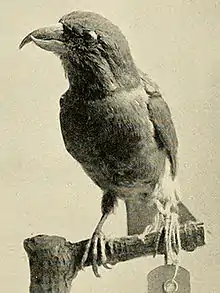
| North American red crossbill subspecies based on biometrics | Jeff Groth's list using call types | Recorded on tree species (Jeff Groth call types) |
|---|---|---|
| Newfoundland crossbill, L. c. percna | Type 8 | black spruce (Picea mariana) |
| Lesser crossbill, L. c. minor | Type 3 | western hemlock (Tsuga heterophylla) |
| Sitka crossbill, L. c. sitkensis (probably a junior synonym of L. c. minor) | Type 3 | ditto |
| L. c. neogaea | Type 1 | Tsuga species, Picea glauca, Pinus strobus |
| L. c. neogaea | Type 4 | Douglas fir (Pseudotsuga menziesii) |
| Rocky Mountain crossbill, L. c. benti | Types 2, 7 | Type 2: Rocky Mountains ponderosa pine (Pinus ponderosa scopulorum) in the west, various Pinus species in the east; Type 7: possibly a general diet |
| Sierra crossbill, L. c. grinnelli | Type 2, 7 | ditto |
| Bendire's crossbill, L. c. bendirei | Type 2, 7 | ditto |
| Mexican crossbill, L. c. stricklandi | Type 6 | pine species in section Trifoliae |
| Central American crossbill, L. c. mesamericana | ||
| Cassia crossbill (described as Loxia sinesciuris in 2009)[8] | Type 9 | isolated population of the lodgepole pine (Pinus contorta latifolia) |
References
- BirdLife International (2012). "Loxia curvirostra". IUCN Red List of Threatened Species. 2012. Retrieved 26 November 2013.
- Benkman, C. W.; Parchman, T. L.; E. Mezquida (2010). "Patterns of coevolution in the adaptive radiation of crossbills". Annals of the New York Academy of Sciences. 1206: 1–16. doi:10.1111/j.1749-6632.2010.05702.x. PMID 20860680. S2CID 17263990.
- Benkman, C. W. (2003). "Divergent selection drives the adaptive radiation of crossbills". Evolution. 57 (5): 1176–81. doi:10.1554/0014-3820(2003)057[1176:dsdtar]2.0.co;2. PMID 12836833.
- Oiseaux.net. "Bec-croisé des sapins - Loxia curvirostra - Red Crossbill". www.oiseaux.net. Retrieved 2020-09-29.
- Perry, Richard Wildlife in Britain and Ireland Croom Helm Ltd. London 1978 pp. 134–5.
- Bewick, Thomas (1847). A History of British Birds, volume I, Land Birds (revised ed.). pp. 234–235.. Roger Twysden's Latin note on the 1593 outbreak is given in William Wats's edition of Paris's Chronica Majora (London, 1640).
- Jobling, James A. (2010). The Helm Dictionary of Scientific Bird Names. London, United Kingdom: Christopher Helm. pp. 125, 231. ISBN 978-1-4081-2501-4.
- Benkman, Craig W.; Smith, Julie W.; Keenan, Patrick C.; Parchman, Thomas L.; Santisteban, Leonard (2009). "A New Species of the Red Crossbill (Fringillidae: Loxia) From Idaho". The Condor. 111 (1): 169–176. doi:10.1525/cond.2009.080042. hdl:20.500.11919/2936. S2CID 9166193. Archived from the original on 2019-04-29. Retrieved 2019-09-23.
- Parchman, T. L.; C. W. Benkman (2006). "Patterns of genetic variation in the adaptive radiation of New World crossbills (Aves: Loxia)". Molecular Ecology. 15 (7): 1873–1887. doi:10.1111/j.1365-294x.2006.02895.x. PMID 16689904. S2CID 41768936.
- Magnus S Robb: Introduction to vocalizations of crossbills in north-western Europe
External links
| Wikimedia Commons has media related to Loxia curvirostra. |
- Bangs, Outram (12 October 1932). "Birds of Western China Obtained by the Kelly–Roosevelt Expedition". Field Museum of Natural History Publication, Zoological Series. 18 (11): 343–379.
- Ageing and sexing (PDF; 2.9 MB) by Javier Blasco-Zumeta & Gerd-Michael Heinze
